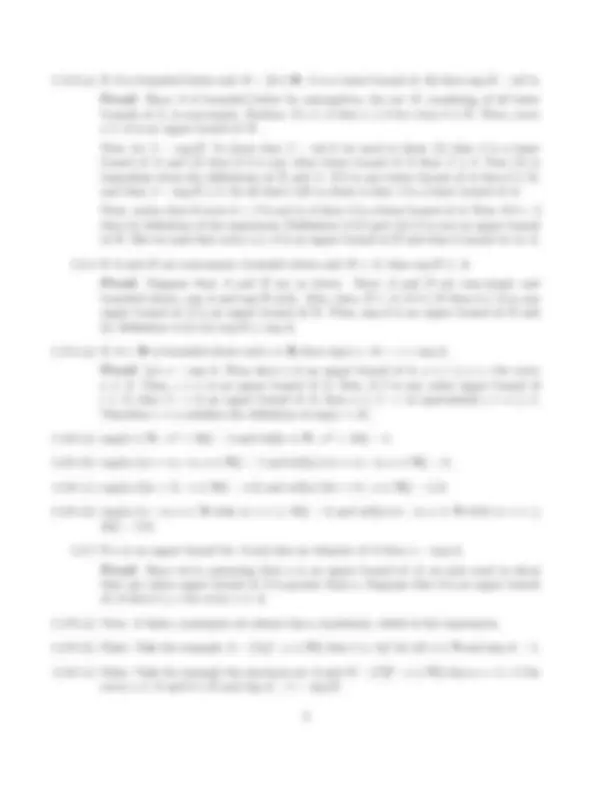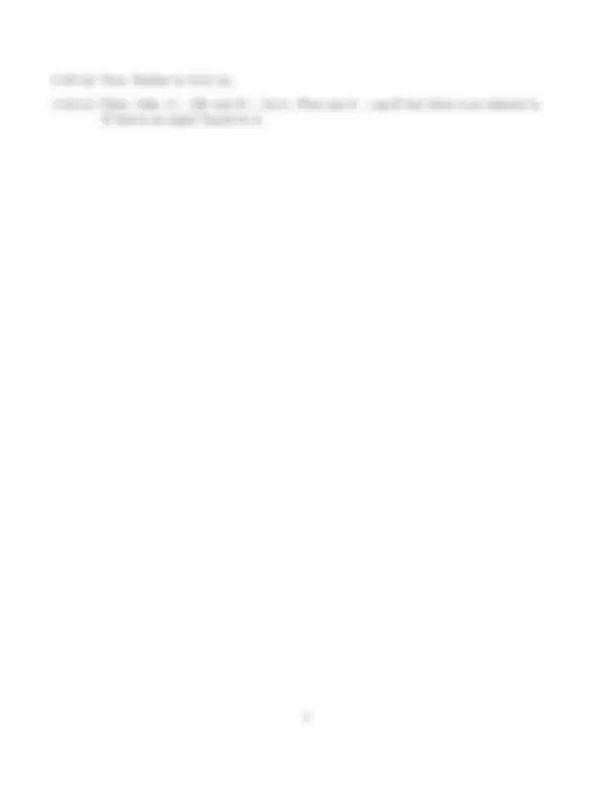




Study with the several resources on Docsity

Earn points by helping other students or get them with a premium plan


Prepare for your exams
Study with the several resources on Docsity

Earn points to download
Earn points by helping other students or get them with a premium plan
Community
Ask the community for help and clear up your study doubts
Discover the best universities in your country according to Docsity users
Free resources
Download our free guides on studying techniques, anxiety management strategies, and thesis advice from Docsity tutors
Material Type: Assignment; Professor: Moorhouse; Class: Real Analysis I; Subject: Mathematics; University: Colgate University; Term: Unknown 1989;
Typology: Assignments
1 / 4

This page cannot be seen from the preview
Don't miss anything!



Math 323 – Real Anlaysis – Homework 1 Solutions
1.2.2 (b) True: Since ∩∞ i=1Ai ⊂ A 1 and A 1 is finite, the intersection must be finite. Next, we must show that ∩∞ i=1Ai 6 = ∅. In other words, we need to show that there exists some x ∈ An, for all n ∈ N. Suppose there is no such x then we will show that there is some set AN which is empty. (In other words, we argue by contrapositive.) Since A 1 is finite, we can number its elements: A 1 = {x 1 , x 2 , ..., xm}. For each k, the element xk 6 ∈ ∩∞ i=1Ai, and thus, there is some Nk such that xk ∈/ An for n ≥ Nk. But now, if N ≥ Nk for each k = 1, 2 , ..., m then AN ∩ A 1 = ∅. Since AN ⊂ A 1 this means that AN = ∅.
1.2.2 (c) False: Take B = ∅ then A ∩ (B ∪ C) = A ∩ C and (A ∩ B) ∪ C = C. But for any choice of A and C such that A 6 ⊃ C, A ∩ C 6 = C.
1.2.2 (d) True: This is the Associative Law for Sets. The following string of ”if and only if” (iff) statements constitutes the proof:
x ∈ A ∩ (B ∩ C) iff x ∈ A and x ∈ (B ∩ C) iff x ∈ A and (x ∈ B and x ∈ C) iff (x ∈ A and x ∈ B) and x ∈ C iff (x ∈ A ∩ B) and x ∈ C iff x ∈ (A ∩ B) ∩ C.
1.2.2. (e) True: This is the Distributive Law for Sets. The following string of ”if and only if” statements is the proof.
x ∈ A ∩ (B ∪ C) iff x ∈ A and x ∈ (B ∪ C) iff x ∈ A and (x ∈ B or x ∈ C) iff (x ∈ A and x ∈ B) or (x ∈ and x ∈ C) iff (x ∈ A ∩ B) or (x ∈ A ∩ C) iff x ∈ (A ∩ B) ∪ (A ∩ C).
1.2.3 (a) (A ∩ B)c^ ⊂ Ac^ ∪ Bc
Proof: If x ∈ (A ∩ B)c^ then x 6 ∈ A ∩ B then x 6 ∈ A or x 6 ∈ B then x ∈ Ac^ or x ∈ Bc then x ∈ Ac^ ∪ Bc
1.2.3 (b) (A ∩ B)c^ ⊃ Ac^ ∪ Bc
Proof: If x ∈ Ac^ ∪ Bc^ then x ∈ Ac^ or x ∈ Bc^. then x 6 ∈ A or x 6 ∈ B then x 6 ∈ A ∩ B then x ∈ (A ∩ B)c.
By part (a) the reverse inclusion is true and thus (A ∩ B)c^ = Ac^ ∪ Bc.
1.2.3 (c) The following string of if and only statements constitutes the proof: (A ∪ B)c^ = Ac^ ∩ Bc
Proof: If x ∈ (A ∪ B)c^ iff x 6 ∈ A ∪ B. iff x 6 ∈ A and x 6 ∈ B iff x ∈ Ac^ and x ∈ Bc iff x ∈ Ac^ ∩ Bc
Thus, (A ∪ B)c^ = Ac^ ∩ Bc.
1.2.5 (a) |a − b| ≤ |a| + |b|.
Proof: Making the substitution c = −b and applying the usual triangle inequality gives |a − b| = |a + c| ≤ |a| + |c| = |a| + | − b| = |a| + |b|.
1.2.5 (b) ||a| − |b|| ≤ |a − b|.
Proof: Let c = a − b, then a = c + b and by the usual triangle inequality
|a| = |c + b| ≤ |c| + |b| = |a − b| + |b|
and subtracting |b| from both sides gives |a| − |b| ≤ |a − b|. By a symmetric argument |b| − |a| ≤ |b − a| and thus ||a| − |b|| ≤ |a − b|.
1.3.2 (a) Definition: A real number t is the greatest lower bound or infimum of a set A ⊂ R if the following two conditions are satisfied:
(a) t is a lower bound for A; (b) if c is any lower bound for A, then t ≥ c.
1.3.2 (b) Assume t ∈ R is a lower bound for the set A ∈ R. Then t = inf A if and only if, for every choice of ≤ > 0 , there exists an element a ∈ A satisfying s + ≤ > a.
1.3.9 (d) True: Similar to 1.3.5 (a).
1.3.9 (e) False: Take A = { 1 } and B = (0, 1). Then sup A = sup B but there is no element in B that is an upper bound of A.